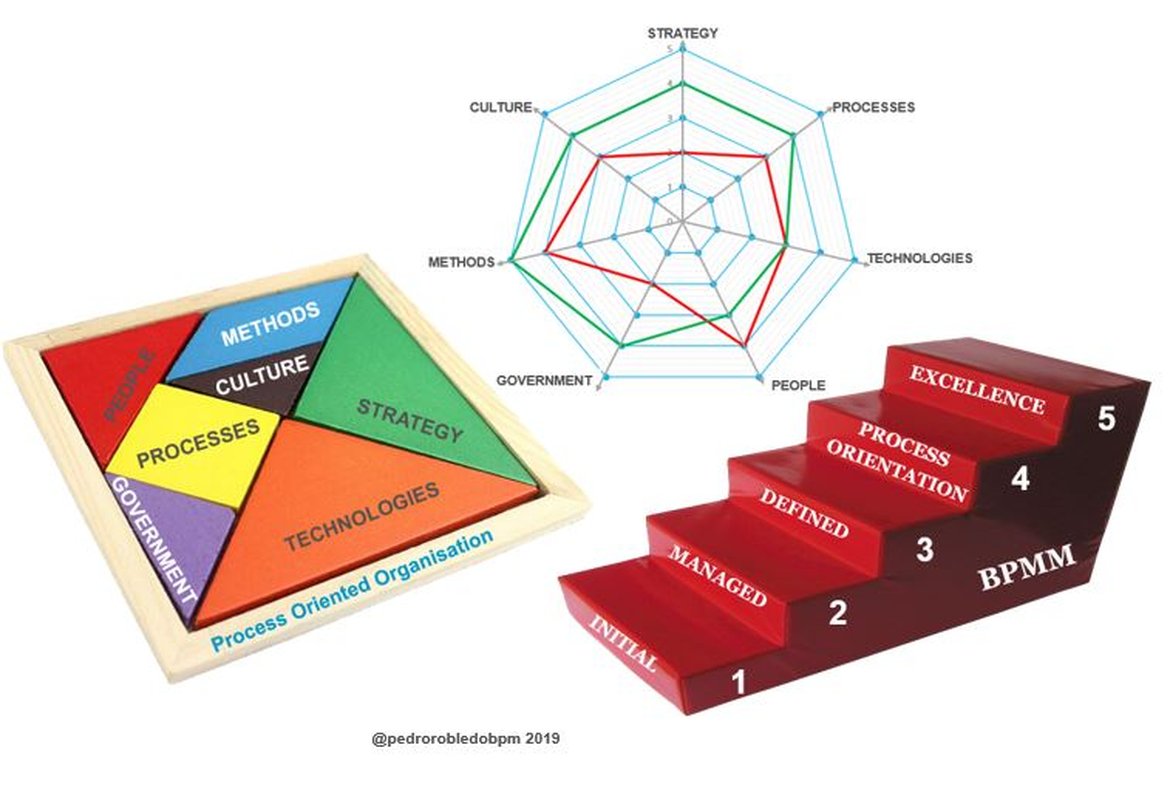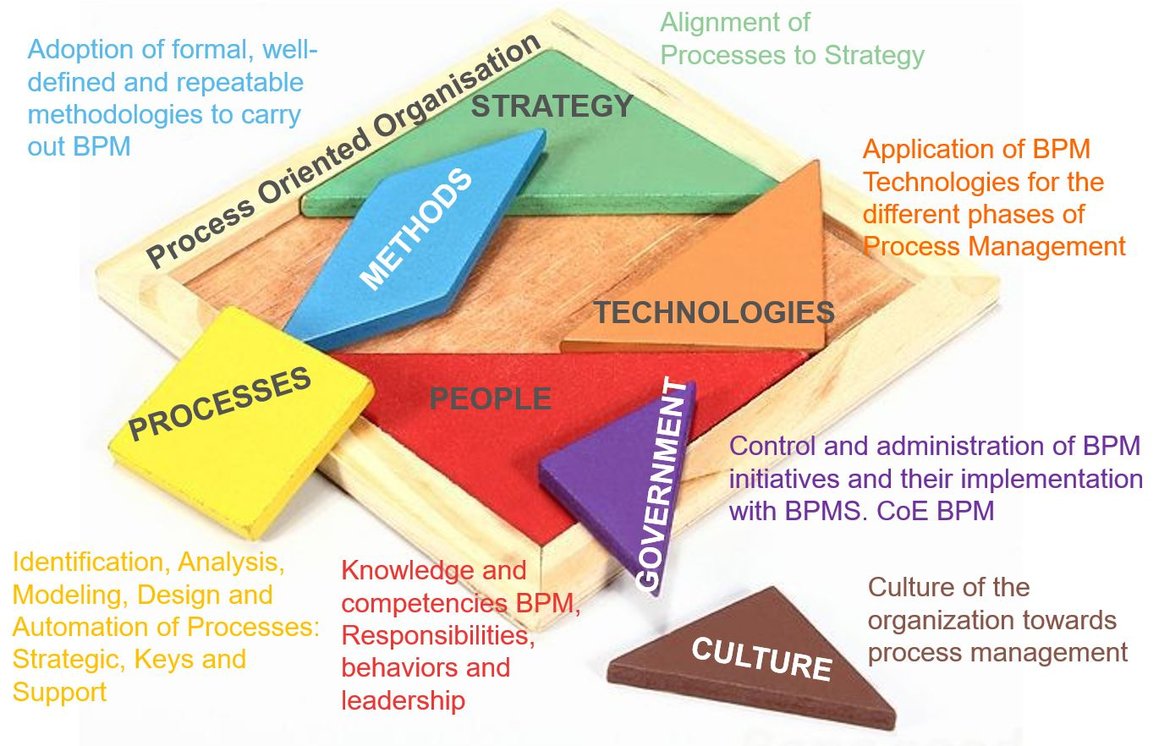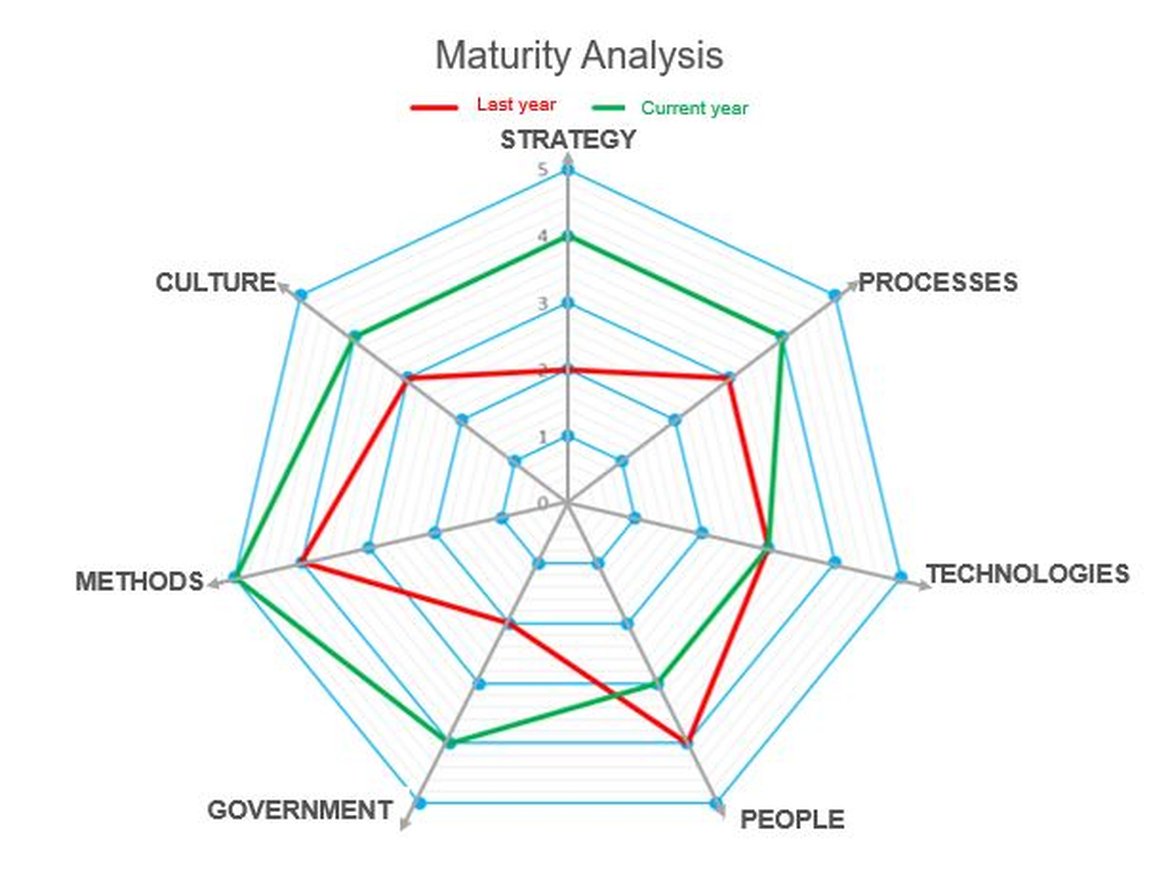¡HI! If you want to propose us a project, send a mail to info@albatian.com


ALL INFORMATION ABOUT
BPM, PROCESS, R & D, TECHNOLOGY
How to guide organizations in Maturity in BPM?
By: Pedro Robledo, BPM process management expert

The selection of software for the technological implementation of the Business Process Management (BPM) discipline will depend mainly on whether we want to cover the entire BPM life cycle or only some of its phases. The selection methodology explained below is valid for both cases, but when defining the evaluation criteria, it will be necessary to take into account what is the scope sought (with respect to the BPM life cycle), in order to evaluate similar products.
A Process Oriented Organization is one that, following the principles of the management discipline of BPM (Business Process Management), recognizes the importance of the processes that define the value chain of your business, deals with the management thereof and treats them as assets of the company. Business processes must be cared for, maintained and managed correctly in order to create value for their clients through the processes they execute.
The transformation of a traditional functional organization to a process-oriented company implies a significant change in the corporate culture, being the most critical success factor for the success of any BPM initiative in the organization. To manage the change of a BPM implementation, it will be necessary to lead a project that motivates those involved in the change, to assimilate that it is a change to improve and achieve short-term achievements over time.
When a company is process-oriented implies that the responsibility for the results obtained is established on the transversal processes and not on the functional level of the organizational units, and also identifies which processes participate in the strategic compliance of the company, so that they will optimize those processes according to their contribution in the objectives to be reached. But on the way to achieve Excellence in Processes, the company goes through different levels of maturity in processes.
Maturity as a measure to evaluate the capabilities of an organization in regard to a particular discipline has become very popular since the Institute SEI (Software Engineering Institute) of Carnegie Mellon University proposed the model CMM (Capability Maturity Model) for the evaluation of software development processes. This model has been used to apply it in other approaches such as, for example, IT Infrastructure Management, Enterprise Architecture Management and Knowledge Management; and also, for Process Orientation of an organization.
Many organizations use maturity models (Business Process Maturity Models - BPMM) to check how well their organizations manage their processes. BPMM is a model that we must consider when starting any process management project, improvement of the same or BPM project and can be used by organizations to:
- Describe the state of how our organization is, its strengths and weaknesses in relation to process management.
- Prescribe the path we must follow to advance in process management and improvement of them.
- Compare the status of our organization with respect to standards and other organizations and as a benchmarking tool.
- Ensure the culture of continuous improvement of the business processes of an organization
Different Maturity Models in BPM
The company can be guided in different Maturity Models in BPM (BPMM) proposed by different authors. In the following figure, we see a comparison of several reference models:
|
BPMM |
Level 1 |
Level 2 |
Level 3 |
Level 4 |
Level 5 |
|
Fisher (2004)
|
Silos: Individual optimization. The information tends to be in silos. Reactive to market changes in 1-2 years. |
Tactical integration: IT leads the effort to integrate the organization. Functional organization Focus on the efficiency of the function, instead of end-to-end process optimization. Adaptation / Reactive to market changes in 12 months. |
Process orientation: The business process is the fundamental element of the company. Adaptation / Reactive to market dynamics within 3-6 months. Focus on BPO (Business Process Outsourcing). |
Optimized Company: Adaptation / reactive to market dynamics in a matter of weeks. Process Oriented Company. Teams responsible for the overall performance of the process. Total integration of the process throughout the company. |
Intelligent Operating Network: Continuous adaptation of market dynamics in almost real time. Predictive capabilities. The company and its suppliers are organized process-oriented. |
|
Rosemann (2005)
|
Initial: Attempts towards BPM are non-existent or very uncoordinated and unstructured (Ad-hoc, individual efforts) |
Repeatable: First experiences BPM experiences and beginning to build competence in BPM and increasing the number of people who see the organization from a process perspective. |
Defined: Greater momentum in the development of competencies in BPM and the number of people who see the organization from a process perspective. |
Managed: The organization benefits from having BPM firmly rooted in the organization's strategic. |
Optimized: BPM is a fundamental part of both the strategic management and the operational management of the organization. |
|
OMG (2008)
|
Initial: inconsistent business processes sometimes with difficult to predict results |
Managed: Management stabilizes the work in a repeatable way in the work units even though they can use different procedures. |
Standardized: standard processes of best practices identified in the working groups and adaptation guides to support different business needs. |
Predictable: Process performance control to manage an intermediate state that predicts a variation of the future result. |
Innovate: Proactive and opportunistic improvement actions seek innovations to achieve their business objectives. |
|
CMMI (2010)
|
Initial: Process unpredictable, poorly controlled and REACTIVE. |
Managed: Process by PROJECTS and MANAGE. |
Defined: Process managed by the ORGANIZATION and is PROACTIVE. |
Quantitatively Managed: Process QUANTITATIVELY measured and controlled. |
Optimized: Focused on the CONTINUOUS IMPROVEMENT of the process. |
|
Gartner (2013)
|
Process Consciousness: Recognize the operational challenges. Document high-level business processes. |
Coordinated Processes: Owners of identified processes. Automation of routine activities. First approach of business process competency center (BPCC). Execution of projects with quick successes. |
Transversal Process Management: Full BPCC. Organized the processes, policies and structure for the Government of Processes. Business results are monitored and adjusted for effectiveness.
|
Target-oriented processes: Process Hierarchy now aligned with the strategic objectives. The process models synchronized with the execution of the process. The operational processes are measured, monitored and adjusted in real time. |
Optimized Processes: Optimization technologies in the use of resource constraints to maintain balance in processes. Excellence in processes. |
|
Robledo (2014)
|
Initial: No alignment of the processes towards the business strategy. BPM pilots. No BPMS. Lack of BPM knowledge. No commitment Address. Difficult management of market changes. |
Managed: Process map defined and documented. I use Modeling tools and some processes in BPM. Some involvement of the Directorate. First performance metrics. Process management to facilitate change management. |
Defined: BPM team Defined BPM strategy and Roadmap of Processes. Control panel of the automated processes linked to the business strategy to have the operational response capacity of the business. |
Process orientation: Company managed by processes. Strategic and operational control panels related to the processes, with quick and agile business response capability. Center of Excellence in BPM formed. Always use BPMS for process automation. |
Excellence: Organization oriented by processes. Complete alignment of the processes to the business strategy, performing a predictive, proactive and reactive management of the business in real time. Alignment of management by processes with other business management, always seeking Excellence. |
Comparative Table of Process Orientation Maturity Models
Maturity Models in BPM (BPMM Robledo, 2014)
In 2014, I designed my maturity model after a thorough investigation of the critical success factors that are reflected in the different existing maturity models, but above all analyzing three main BPM gurus: Fisher, Rosemann and Jeston-Nelis. Also caused by the different evaluations I have carried out in different companies from different industries.
In my model, I consider 7 key factors of success or pillars necessary to measure the maturity of the process orientation of an organization:
- STRATEGY: Alignment of the Processes to the Organizational Strategy.
- PROCESSES: Identification, Analysis, Modeling, Design and Automation of Processes: Strategic, Keys and Support. Including the definition of business rules and automated processes for decision making.
- TECHNOLOGIES: Application of BPM Technologies for the different phases of Process Management: modeling, design, automation, integration and monitoring. As well as the implementation of technological trends (Social, Mobility, Big Data, Cloud and Internet of Things).
- PEOPLE: Knowledge and competencies BPM, Responsibilities, behaviors and leadership.
- GOVERNMENT: Control and administration of BPM initiatives and their implementation with BPMS. Definition of Scorecards that allow a predictive, proactive and reactive analysis in real time of performance, performance and the achievement of business objectives. Center of Excellence BPM.
- METHODS: the adoption of formal, well-defined and repeatable methodologies to carry out BPM and its continuous improvement.
- CULTURE: Culture of the organization towards process management. Organizational structure oriented to processes. It is not enough to train people, but change the business culture.

7 Key Factors of the Maturity of a Process Oriented Organization
In this model of maturity each of these 7 key factors are divided into five "levels of maturity", so that an organization that has institutionalized all the practices included in a level and its inferiors, is considered to have reached that level of maturity.
Companies must ensure that their business processes are more mature, that they are capable of offering greater performance over time. Companies must provide process enablers that belong to individual processes and business capabilities that apply to the entire organization.
|
|
LEVEL1 |
LEVEL 2 |
LEVEL 3 |
LEVEL 4 |
LEVEL 5 |
|
|
INITIAL |
MANAGED |
DEFINED |
PROCESS ORIENTATION |
EXCELLENCE |
|
STRATEGY |
No alignment of the processes towards the business strategy. Processes are not being evaluated in terms of contribution towards the business strategy. |
There are some metrics or KPIs available for the performance and performance of some processes and there is a certain strategy to improve these metrics. Resource performance metrics are also available. |
It has a complete control panel of the automated processes linked to the business strategy to have the operational response capacity of the business. |
Strategic and operational control panels related to the processes, with quick and agile business response capability. |
Complete alignment of the processes to the business strategy, performing a predictive, proactive and reactive management of the business in real time. Alignment of management by processes with other business management, always seeking excellence. |
|
PROCESSES |
No processes in BPM, only BPM Pilots. |
Few processes in BPM. Process map defined and documented. |
Defined BPM strategy and Roadmap of Processes. |
Automation of 75% of the processes of the organization in BPM. |
Automated processes in BPM throughout the Organization. |
|
TECHNOLOGIES |
No use of BPM technology and no BPM tool selected. |
The organisation uses tools Modeling and design of processes. |
Use of BPMS for process optimization. |
The organization always uses BPMS for process automation. |
Continuous technological innovation to meet the new demands of process orientation and market dynamics. |
|
PEOPLE |
Lack of BPM knowledge. |
Fundamental knowledge in BPM and in modeling and process design. Some involvement of Management. |
Minimum team formed. Definition of Roles and Process Responsibilities. |
The Management carries out a Process Management with knowledge of the contribution of the processes to the business strategy. |
HR manages human resources for their productivity and competencies in the processes that they participate. |
|
GOVERNMENT |
No commitment Address. Difficult management of market changes. The contribution of the processes in the strategy is not evaluated. |
Some involvement of the Directorate. First performance metrics. Process management to facilitate change management. Control of the BPM implementation. |
BPM team Government through a scorecard of automated processes. Use of BPM Government tools. |
Complete training of the Competency and Operations Center. Implementation of Government tools to control and manage process orientation. |
Government of BPM aligned with the Government of other business management (quality, EFQM, Competencies, ISO, Security, Human Resources, Risks, Prevention, Environment ...) |
|
METHODS |
I do not use methodologies. |
Use of formal notation to represent BPM processes. |
Use of methodological approach towards processes. |
Utilization of Enterprise Architecture methodology. |
Use of continuous improvement methodologies with BPM (Lean, Six Sigma, TOC) |
|
CULTURE |
No process culture. |
Conceptual assimilation of the BPM philosophy. |
Company focused on the need for process orientation, defined a cultural change to processes plan. |
Company managed by processes. Execution of Change Management towards BPM. |
Process oriented organization with an organization chart led by Process Directors aligned to the Business Strategy. |
Model of Maturity in BPM based on 7 Key Factors
For the application of the maturity model, the cycle can be structured in three stages: preparation, evaluation and improvement plan.

Cycle to apply the Maturity Analysis model
With this cycle, organizations can develop programs to improve their maturity in BPM easily and simply, involving managers and workers in the transformation of their processes. Being cyclical will seek continuous improvement. Let's see each stage:
1. Preparation
In this stage, three important actions are carried out:
a) Beginning of the evaluation establishing the bases so that the evaluation of maturity is correct and adequate, synchronizing the objectives of the evaluation with the strategic objectives in the short, medium and long term.
b) Perform initial diagnosis of the organization.
c) Formation of the Work Team responsible for executing all the activities. It is normally set up with five people: responsible for the process, member of the board of directors, responsible for quality and experienced executors. Although people could participate outside the organization that provide value in the evaluation. A team person will be designated as a team leader.
2. Evaluation
In this stage the level of maturity of each key factor will be determined. Each key factor is evaluated in a table according to five gradual levels of maturity. If an analysis of maturity in an organization is carried out annually taking into account the seven key factors, it can be represented in a radial graph, comparing two consecutive years. This graph guides the organization in what factors attention must be paid to level up, so that a specific plan can be defined for each key factor.

Graphic Analysis of the Evolution of the Maturity of a Process Oriented Organization
3. Improvement Plan
In this stage, the results of the previous stage are analyzed and a concrete improvement plan is determined according to the priorities of the organization and taking into account the objective of reaching higher levels of maturity.
RELACIONADO
-
How to select a BPM software?
by 4 Dec. 17, 2018
-
Before automating a process ... improve it!
by 4 Jan. 8, 2020
-
Gestión del Conocimiento como Estrategia Empresarial
by 4 Feb. 22, 2021
-
Does your company have a Digital Culture?
by 4 Dec. 17, 2018
-
Why BPM is vital for companies in the energy and utility industry
by Albatian July 13, 2020
-
Where to learn BPM in the University?
by 4 Nov. 2, 2018
-
Why BPM is Vital for Insurance Companies
by 4 Feb. 22, 2021
-
Process Mining plays an essential role in Digital Transformation
by 4 Sept. 6, 2018
-
More than 66% of BPM employment is not covered due to lack of professionals
by 4 Feb. 8, 2018
-
Differences between Processes, Procedures and Work Instructions
by 4 Dec. 7, 2017
-
How to Calculate the ROI of a BPM Initiative?
by 4 July 9, 2017
-
Not enough with an independent Management of a Process
by 4 May 9, 2017
-
Any Business Innovation and Transformation requieres an Enterprise Architecture
by Albatian March 27, 2017
-
Process Digitalization in Digital Transformation
by Albatian Jan. 9, 2017
-
BPM is key to the Digital Transformation
by Albatian Oct. 4, 2016
-
¿BPMS for moments of crisis?
by Albatian Nov. 12, 2012











